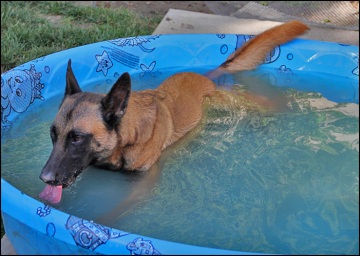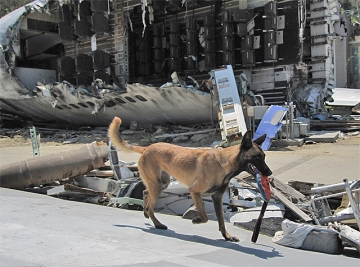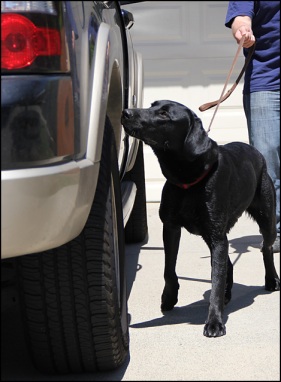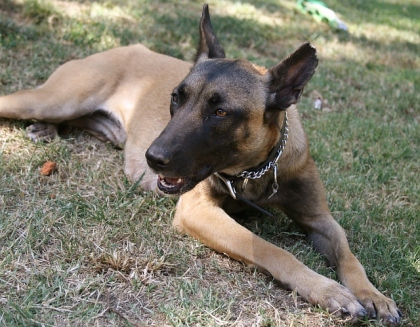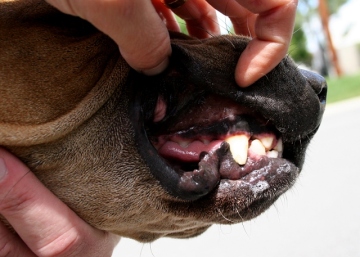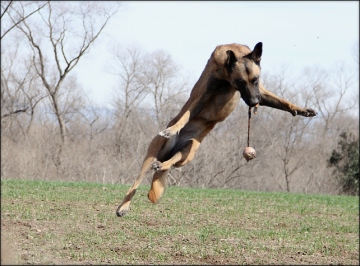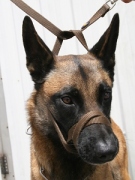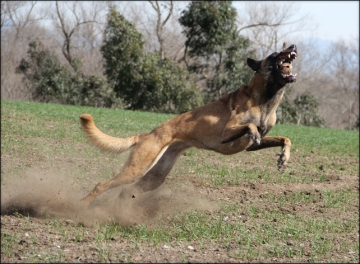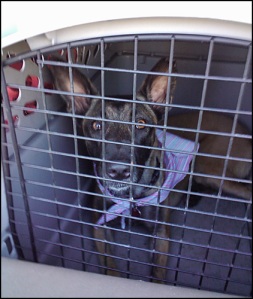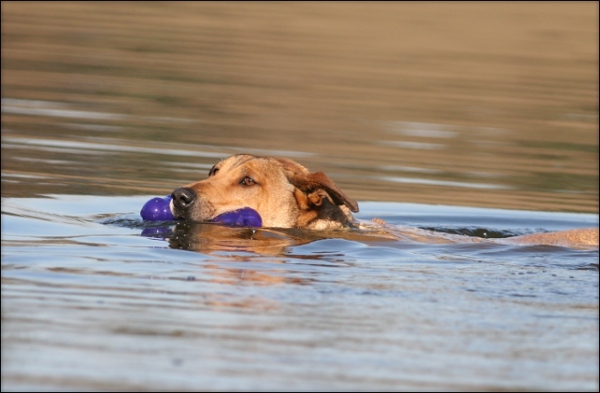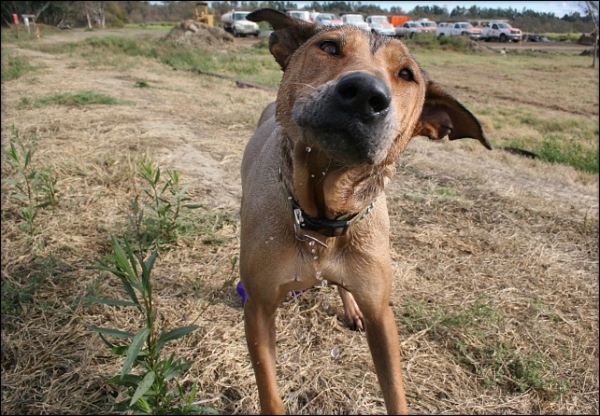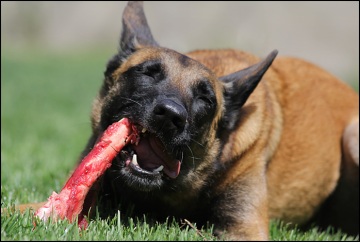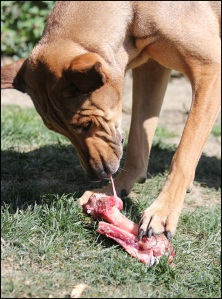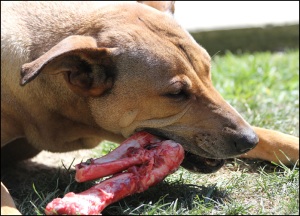Now don’t get me wrong. I do think, most dogs love the outside – at least mine do, and I love the idea to be able to provide my dogs with some off-leash time outside, where they can run, sniff and (yes, admittedly) dig a hole to their hearts desire. But I don’t leave them outside without supervision, or at the very least, I’m always close, listening and ready to react. Here are some reasons why it is not a good idea to leave your dog outside without watching them.
Scaling the Fence
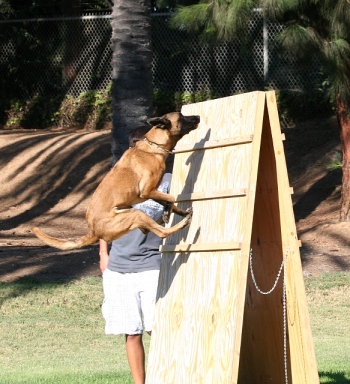 No, of course my dogs would not scale our 6-feet fences. Or would they? Well, they have. Fortunately, they know who feeds them and who has their favorite dog bed. They did not stray far. In fact, one staid on the couch, while the other one barked at our neighbor’s door until he opened, where upon she ran past him to play with her friend, the neighbor’s dog. We have since fortified our fences, fixed the whole and now even feature double fences. Even the most balanced, exercised dogs can decide to make a go for it, when they discover a hole or a rotten piece of wooden fence.
No, of course my dogs would not scale our 6-feet fences. Or would they? Well, they have. Fortunately, they know who feeds them and who has their favorite dog bed. They did not stray far. In fact, one staid on the couch, while the other one barked at our neighbor’s door until he opened, where upon she ran past him to play with her friend, the neighbor’s dog. We have since fortified our fences, fixed the whole and now even feature double fences. Even the most balanced, exercised dogs can decide to make a go for it, when they discover a hole or a rotten piece of wooden fence.
We had a crazy person opening backyard doors in the neighborhood where we lived before. So even if your fences are bomb proof, you never know what’s going to happen. Add the hated neighbor cat down the street, a couple of fast cars and you have the recipe for a disaster.
Unwelcome visitors
I would have never thought it would be possible, but this last weekend made me realize, that I have not seen it all. I do not let our dogs lose in our backyard without being very alert to their behavior. When I heard them bark, the thought crossed my mind, that it was just our neighbor, cutting his tree next to our fence, like he did the days before. But the barks sounded different, so I went and looked. I could not see anything, but there were abnormal noises from the neighbor’s side. I decided to take the dogs inside, when all of a sudden I saw a big brown dog scale our fence, which is in itself 6 feet high and on top of that there is a big bush, which adds about another 4 feet. Well, this dog decided to work his way through the bush. Fortunately, I was able to get the dogs inside just before that visitor hit our backyard ground or it would have meant a bloodbath, as my female dog is quite territorial. Here’s the real kicker though – our neighbor does not have a dog! So I never expected danger in form of a dog from this side. A neighbor four doors (and backyards) down, dogsat for a friend, put the dog in his backyard and drove away. Fortunately, the dog had tags with phone numbers on his collar and I was not afraid of him, so the situation got resolved quickly. But I do not want to even imagine what would have happened, if I had ignored my dogs or – even worse – I would have left them outside and went away.
Now, again, I have double fences on all sides, except towards that neighbor, who does not have a dog!
Danger lurking in the backyard
Have you ever replanted something? Used a new fertilizer? Found a dead animal hidden in the bushes of your backyard? Maybe improved the looks of your garden with some fresh mulch? Found some exotic herbs or flowers? Even though your dog may have never dug a hole, ate a plant or munched on freshly added fertilizer, it may just happen. And it might have a catastrophic outcome. I know of a dog who died after drinking from water which was close to a tree, which, after an abnormal amount of rain, was dripping a lot of sap into that water. That particular tree sap was poisonous and unfortunately killed the dog.
Animals, killed by poison such as rat poison, may smell like a delicious in-between meal for our furry friends, but proof to be deadly. While you control the pesticide in your garden, your neighbor might have a different idea of getting rid of unwanted guests. Rats and/or other animals poisoned by your neighbor might end up on your lawn, being a risk for your dogs.
Poisonous risks aside – there are other dangers in your backyard. Even your dog playing with fallen branches from your trees might cause a hefty vet bill, if said branch ends up stuck in your dog’s throat. Or, if your dog wears a collar, he or she might suffocate while being hung somewhere in a bush. Yes, that is a very pessimistic way to spoil the idyllic picture of dogs happily playing in your backyard, but it might just happen. By the way, there is an easy fix on the collar thing: the breakaway collar still gives you the safety of being able to have a collar (and tags!) on your dog while preventing suffocation accidents.
And everything else
 Oh, yes, if you can think of it, it can happen. A couple of months ago, I was just able to get the dogs inside before a huge swarm of bees occupied our backyard. While some of you say, that swarming bees won’t sting anyone, I was not about to try that out with our old man, who loves to snap at everything tiny that’s flying. And we don’t live out in the boonies! What if your dog turns out to be allergic to a bee sting? If you are not scared by bees, what about rattle snakes? Scorpions? Yes, I was laughing at that one, too, until I found one on a walk one day. We live in Southern California, in the suburbs, not on some sort of farm land. You know the dangers of your area best.
Oh, yes, if you can think of it, it can happen. A couple of months ago, I was just able to get the dogs inside before a huge swarm of bees occupied our backyard. While some of you say, that swarming bees won’t sting anyone, I was not about to try that out with our old man, who loves to snap at everything tiny that’s flying. And we don’t live out in the boonies! What if your dog turns out to be allergic to a bee sting? If you are not scared by bees, what about rattle snakes? Scorpions? Yes, I was laughing at that one, too, until I found one on a walk one day. We live in Southern California, in the suburbs, not on some sort of farm land. You know the dangers of your area best.
What can you do?
Some dogs prefer the outside. Some people prefer the dogs to be outside. It’s all legitimate, if precautions are being taken and it is clear, that there are risks, that may not necessarily be the same for a dog, who has access to the indoors. If a dog is to stay outside, I prefer a nice, safe kennel. When you build it yourself, make sure, you have a solid foundation, don’t just buy a kennel from Home Depot and put it up. Make sure, that you have an area that provides shade at all times and enough water. If your dog stays outside in all weather and day and night, make sure, you provide shelter for your dog, be that from the heat or the cold. Be certain, that the drinking water does not freeze. Personally, I prefer a kennel to be situated, where neither a neighbor nor someone from the street has access to. Yes, I’m paranoid like that.
If you don’t have space for a kennel, check your fences regularly. Make sure, that they are high enough for your dog not to be able to jump over them. Add a second fence for safety, if you think it’s necessary. Check on your dogs often. Make sure they have ample water and shade or shelter from the cold. Know their bark! Learn to distinguish their ‘it’s the mailman’ bark from the ‘there’s an intruder’ or ‘I’m hurt!’ bark. Act fast, when you think there’s something wrong. Let your vet know that your dog has been outside unsupervised if something happens and also inform him or her of any new additions to your backyard (plants, fertilizer, pest control). Use a breakaway collar for your dogs with tags. Microchip your dogs!
Finally, obedience train your dogs and exercise them daily. Tired dogs are less likely to go hunting for neighbor’s cat. They are also less likely to be anxious and scale the fence to go look for you. Obedient dogs will come when you call them and you are more likely to be able to bring them to safety, if some coyotes are wandering into your backyard.

